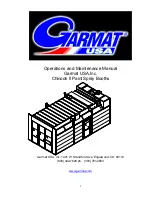
18
AIM-OM-ATX-3, Rev. 2.1, 05/15
• Copyright Orenco Systems
®
, Inc. Property of Orenco Systems
®
, Inc. Do not reproduce or distribute without written authorization from Orenco: 800-348-9843.
AdvanTex
®
O
&
M
MANUAL
C O M M E R C I A L T R E A T M E N T S Y S T E M S
Annual Maintenance
Measure the scum and sludge accumulation in all tanks annually. Record
scum and sludge measurements on a
Field Maintenance Report Form
.
1.
Measuring the scum layer:
Using a scum utility measuring
gauge or similar tool, measure the thickness of the scum layer.
With this measurement, determine if the distance from the bottom
of the scum layer at the liquid’s lowest normal level to the bottom
of the outlet tee or to the top of the inlet holes for the pump vault is
3 inches (76 mm) or less. If so, it’s time to pump out the contents
from the tank (scum, sludge, and liquid) completely. After removing
the septage contents from the tank, refill it with water to its normal
operating level.
2.
Measuring the sludge layer:
Using a Sludge Judge
®
or
similar tool, measure the thickness of the sludge layer. With this
measurement, determine if the distance from the top surface of the
sludge to the bottom of the outlet tee or inlet holes for the pump
vault (PVU) is 6 inches
(152 mm) or less. If so,
again, it’s time to pump out
the contents from the tank
(scum, sludge, and liquid)
completely. If the tank is
fitted with a pump vault
or effluent filter discharge
assembly, take the
measurement from the top
surface of the sludge layer
to the bottom of the vault’s
inlet ports. After removing
the septage from the tank,
refill it with water to its
normal operating level.
NOTE:
Turn the laterals in the AdvanTex
®
treatment unit 180 degrees
(so the spray nozzle turbines face up) prior to flushing to prevent
nozzle clogging while material is being pushed along the lateral to
the flushing valve.
Once a year, send copies of the complete activity log to the appropriate
person. This information is very valuable for analysis and troubleshooting if
problems should occur.
Check voltages and amperages of all pumps and record them on a
Field
Maintenance Report Form
. Refer to the start-up voltages and amperages
recorded in the “Start-up & Operation” section of this document. If the
voltage drop or amperage exceeds NEC requirements, have an electrician
verify the service line and check pump windings.
The pumping system should be inspected annually to ensure it is
operating properly. Unscrew the stainless steel bolts that fasten the
fiberglass lid over the pumping equipment. Remove the fiberglass lid for
an inspection that includes these steps:
a. Verify there are no obvious holes or leaks in the riser or around the
perimeter of the riser connection to the tank. Wetness or watermarks
may be an indication of weeping.
b. Inspect the splice box to ensure it is free of water. Ensure the lid and
connections are secure.
c. Verify the floats are in good condition and properly secured to the
float tree. Verify the float cords are neatly wrapped inside the riser so
that they cannot interfere with the operation of the floats.
d. Verify float operation. Refer to the float tests in the “Start-up &
Operation” section of this document.
All TCOM control panels contain a lithium battery for backup. For good
measure, we recommend you replace the battery every two years. Refer
to “Battery Replacement” in the
Custom TCOM Control Panels and
HyperTerminal Access Manual,
provided in Appendix F.
Maintenance (continued)







































